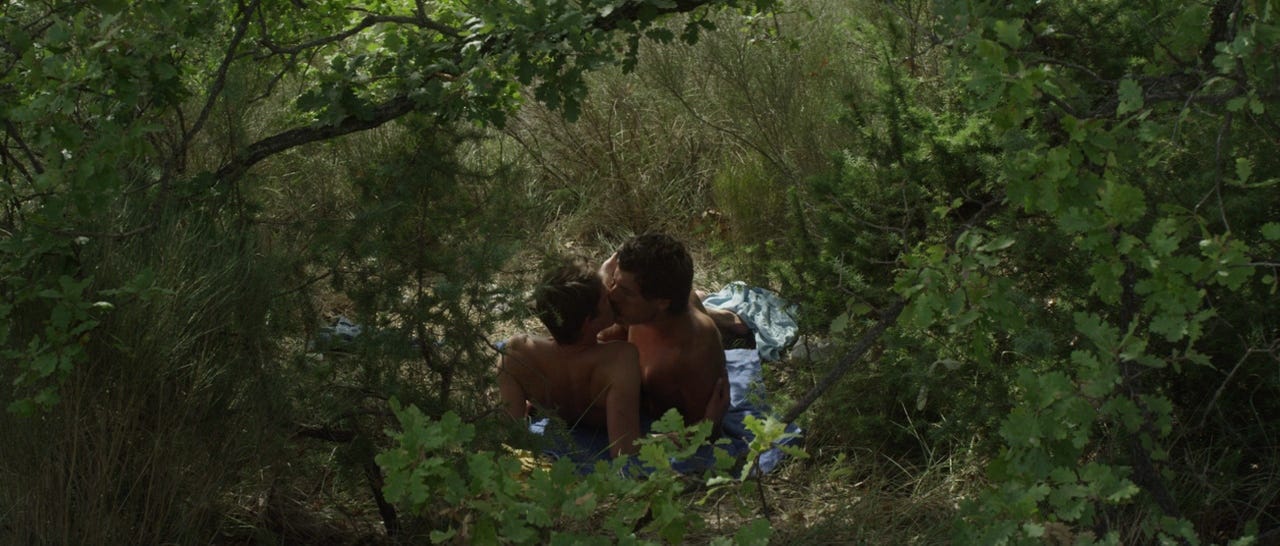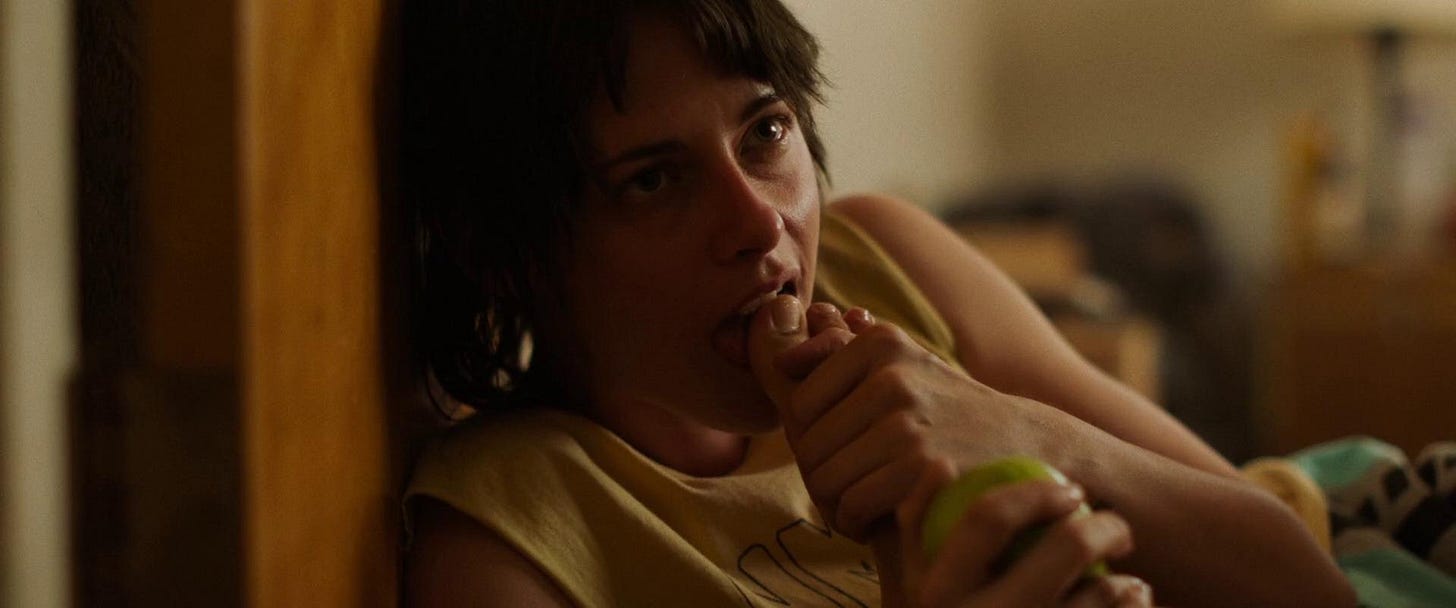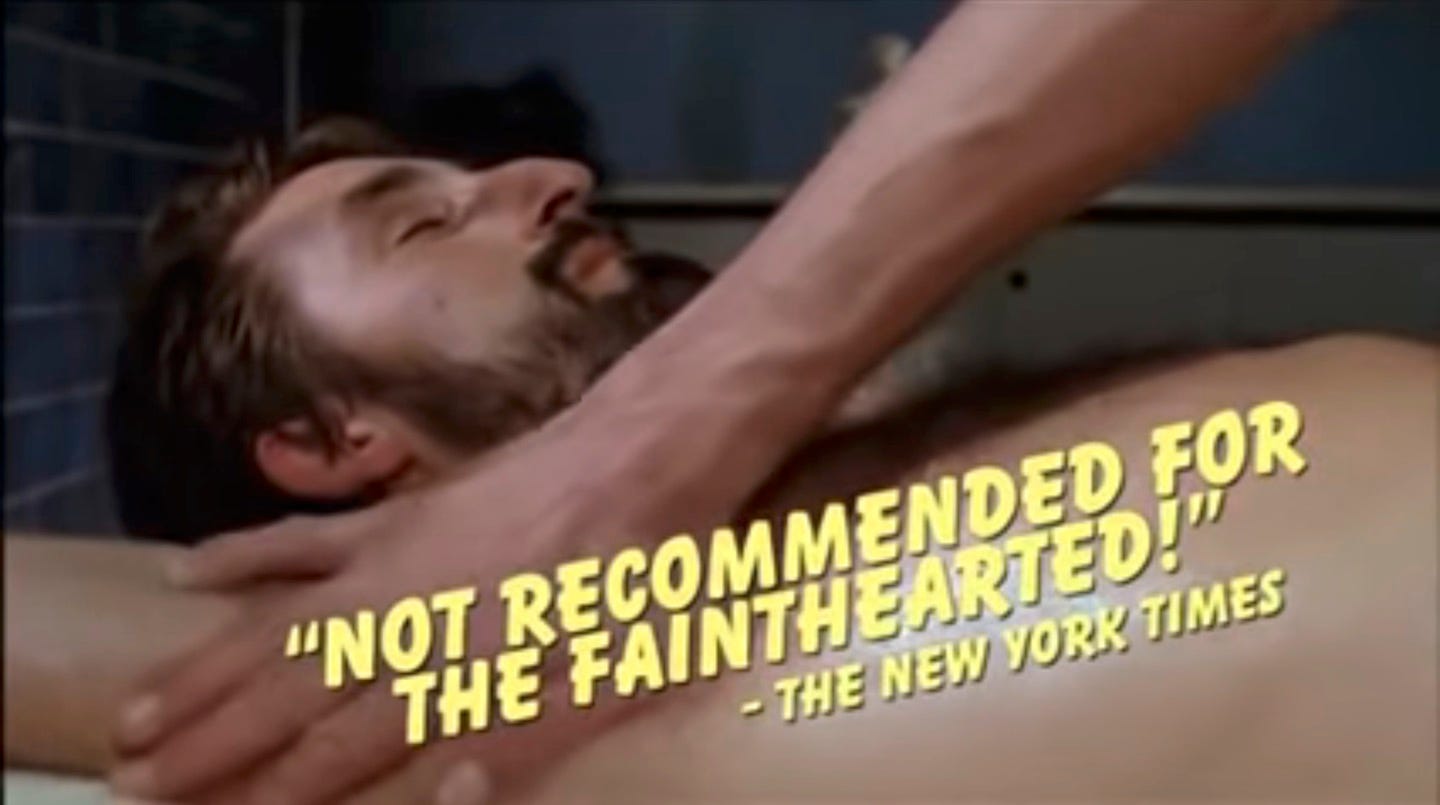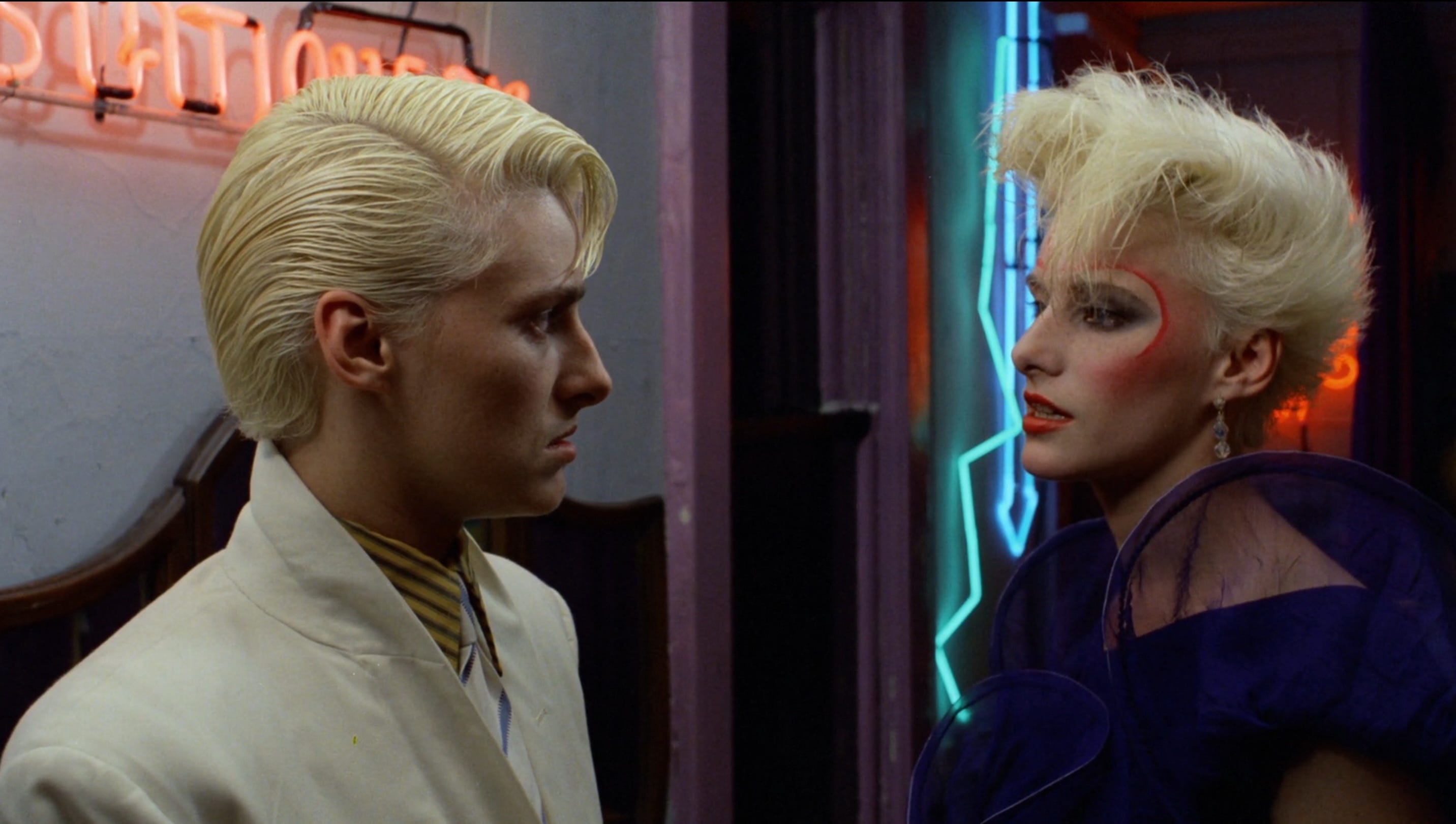
Welcome to June streaming.
This week, Mo—a frequent Spread contributor whose titles around these parts run the gamut from Gay Intern, Chief Gay Correspondent, and, most recently, Intrepid Erotic Gay Art Specialist—and I went to a screening of Taxi zum Klo (1980), a German dramedy—and forgotten gay classic—about cruising culture full of unsimulated sex. Surprisingly popular and successful on release and even given a VHS release in subsequent years, the film has fallen out of print in the age of DVD/streaming and is extremely difficult to find. Our restored print, which thrillingly put back in all the previously censored scenes, apparently lacked subtitles. The theater offered full refunds and the promise of rescheduling next month, but we stayed (it’s Pride!) and tried to make sense of the film1, which was just fascinating.
That’s the thing about queer cinema: it has persisted, in every country, against every conceivable roadblock, including: harsher censorship of gay sex scenes; fascism; a lack of support from major studios; and minimal funding for “niche” artistic visions, to name just a few. In the age of streaming, it should be easier than ever to watch these films, but many face the exact same kind of fraught access, due to the longstanding history of censorship of queer-themed content (consider the early films of Gregg Araki, included here, recently restored by the UCLA Film & Television Archive to their original anarchic, decidedly queer visions). As we celebrate Pride this month, I wanted to finally launch a proper primer on queer cinema, built from our years of programming and personal research and viewership. To that end, we’re keeping it relatively simple with just three programs: Queer Cinema - Essentials, Queer Cinema - Next Steps, and Queer Cinema - Deep Cuts. The distinctions seem rather self-explanatory.

When Vito Russo published The Celluloid Closet in 1981, developed from his lectures as early as 1972 and later made into a 1995 documentary film, it was widely perceived as the first attempt to survey the complex depiction of LGBTQ+ stories throughout American film history, including the (often unsavory) queer-coded references that might have otherwise gone unnoticed by modern cinephiles. It’s from this survey that queer film historians and cinephiles understand that building a kind of authoritative list of queer film would necessarily mean engaging with — and weeding out — films with problematic depictions of queer people: when the Hays Code collapsed over the course of the 1950s, allowing for a somewhat more open discussion of homosexuality, it coincided with the Lavender Scare, in which people suspected or accused of being gay, and thus a threat to prosperous post-War American life2, lost their livelihoods. Films from the era reflected those discriminatory attitudes, and it would take mainstream Hollywood many, many years to catch up; in the meantime, independent artists, operating from the margins on shoestring budgets, made some of the greatest films in queer cinema history, taking advantage of the emerging independent film scene and arthouse theater circuit to get their works to the people who needed them most. Internationally, the story wasn’t much different: after the death of Franco in Spain; after the collapse of fascism in Italy; in reaction to austerity and Thatcherism in the U.K.; wherever conservative or far-right movements have crushed vulnerable populations, there’s been queer art. Film, often smuggled or distributed through circuitous methods, remains the most dynamic form for artistic expression by subjugated classes and communities.
What qualifies as “Queer Cinema?” In this age of seeming inclusivity — always precarious, as history teaches us — the distinction can be hard to maintain, particularly as there is a flood of gay-interest film and television (typically, though not always, with a defanged political stance). To me, Queer Cinema consists of films that articulate the full spectrum of queer life and identity, articulated from the margins (or snuck into seemingly mainstream fare). To that end, you won’t find more recent escapist movies like Love, Simon (2018) or Red, White & Royal Blue (2024), which I loved, because to me, these are gay-centric films, not queer films. I’ve also excluded a number of films from non-queer filmmakers that often are included within the umbrella of queer cinema that have been derided by queer critics over their damaging stereotypes, such as The Crying Game (1992), Tootsie (1982), and Kiss of the Spider Woman (1985), while including some films once categorized as such that have since been embraced by queer and trans cinephiles, like Cruising (1980), Sleepaway Camp (1983), and The Silence of the Lambs (1991). Some movies (and television!) are only here because they’re formative to gay culture and queer-coded to the point that reading it as a queer-coded text has become the dominant form of interpretation (such as All About Eve). And what the hell am I supposed to do with The Children’s Hour (1961)?

All this and more is teased out, messily, in our three collections. I’ve tried to include trigger warnings where relevant, but, well, art angers. Anger is useful, to a point, I think: anger clarifies. Anger motivates. "What do you say we go to Washington and blow Bush's brains out?” a man asks his lover, in Gregg Araki’s The Living End (1992), a film about queer rage released the same year that the CDC cited AIDS as the No. 1 cause of death for U.S. men ages 25 to 44 (as of 2018, it was “Unintentional Injuries,” as a reference). Rage eddies. Stonewall was a riot: a tipping point, following decades of harassment, disenfranchisement, and abuse of queer populations. Queer art should make you upset: it should anger. When German filmmaker and performance artist Rosa von Praunheim made It Is Not the Homosexual Who Is Perverse but the Society in which He Lives / Nicht der Homosexuelle ist pervers, sondern die Situation, in der er lebt (1971), it served as a rallying cry and catalyst for the modern gay rights movement in Germany. In the U.K., the release of Victim (1961), a film about gay blackmail and the first British film to use the word "homosexual," is thought to have helped the passage of the Sexual Offences Act 1967, which legalized gay sex acts (between consenting men over the age of 21).
There’s plenty of rage in these films… and community… and love. There’s every beautiful, messy shadow and blip on the spectrum. I hope you all find something in there to really enjoy.
I should also mention that our queer cinema programming would be incomplete without the aforementioned contributions of Mo Faramawy, a brilliant filmmaker and cinephile who has been my ride-or-die in developing these programs of LGBTQ+ cinema and has helped me as I navigate the spectrum of my sexuality and my own place within the queer community. You’ll find his contributions liberally peppered throughout our Pride Programming (and at least one new queer classic he’s worked on). We keep a running list of our favorite bits of gay content to rip-off for our own unwritten gay erotic masterpiece, which, at this point, seems to be some sort of gay cowboy musical with at least one reference to Valley of the Dolls (1967) and at least one quote from my own mother. He’s the Rock to my Doris.
Without further adieu, follow me…. into an unknown land, full of strange flowers and subtle perfumes; a land of which it is joy of all joys to dream; a land where all things are perfect and poisonous…
Queer Cinema: The Essentials

What it says on the tin: these are your bread and butter works of queer cinema, separated into four rough eras: Pre-Stonewall (1969); Post-Stonewall (“Visibility and Canonization”); the “New Queer Cinema" movement of the early 1990s and its immediate aftermath; and the “New Classics” (2010- Present). This is a great place to start, but it’s by no means definitive. Dive into stories from all corners of the LGBTQ+ spectrum from groundbreaking queer filmmakers like Barbara Hammer, Kenneth Anger, Marlon Riggs, Todd Haynes, Jean Cocteau, Gus Van Sant, Derek Jarman, Stephen Frears, Cheryl Dunye, John Waters, Pier Paolo Pasolini, Rainer Werner Fassbinder, Luchino Visconti, Stanley Kwan, Gregg Araki, Wakefield Poole, Rosa von Praunheim, Andy Warhol, Andrew Haigh, Céline Sciamma, Ira Sachs, Pedro Almodóvar, John Cameron Mitchell, The Wachowskis, and so many more. Plus! Gay classics from non-gay directors (it happens) and groundbreaking works of queer and trans representation. They’re classics, but I promise they’re not stuffy.
Queer Cinema: Next Steps
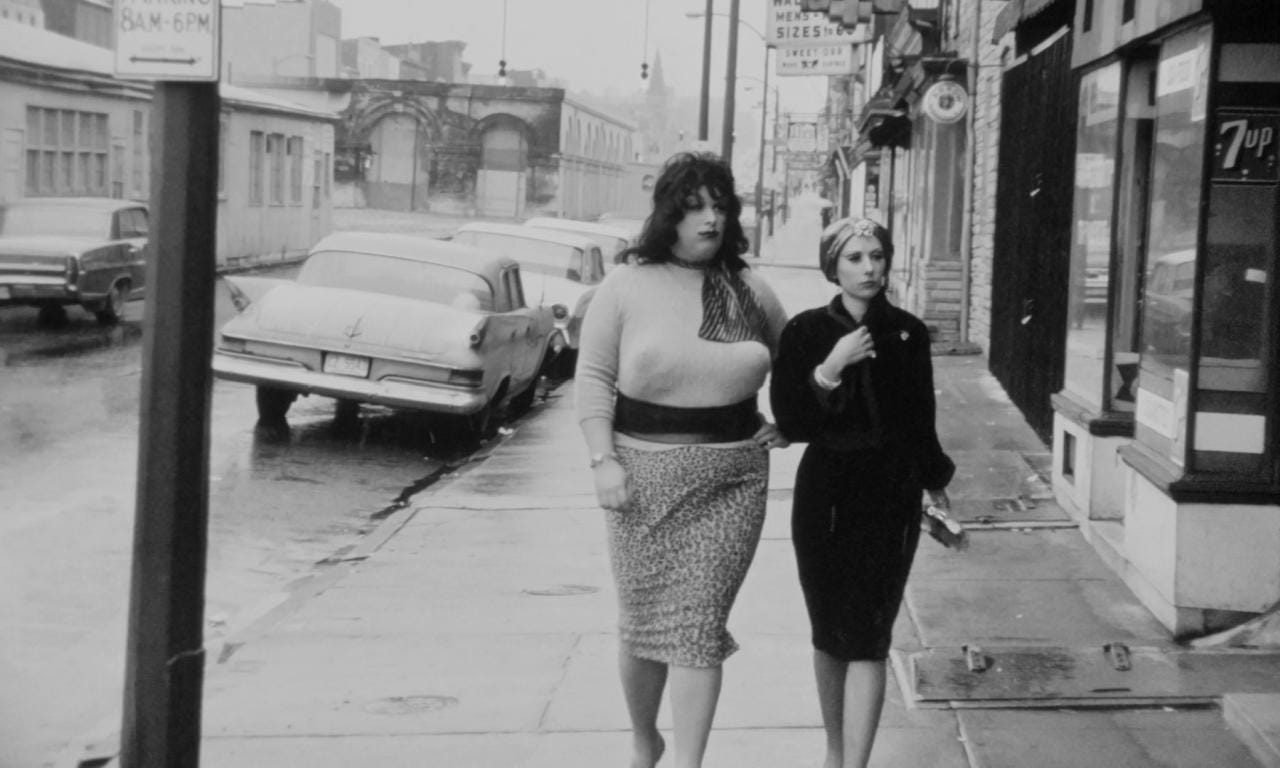
With the heavy-hitters out of the way, we can start having a bit more fun. These are films that may or may not be in the traditional canon, but are well-worth your time. Like Black Lizard / Kurotokage (1968), a Japanese genre film starring rightwing fitness gay Yukio Mishima and legendary drag queen Akihiro Miwa; or lowbrow sapphic masterpieces like Jesús Franco’s Vampyros Lesbos (1971) and Jean Rollin’s Fascination (1979); or the Serge Gainsbourg movie that cast his lover, the late Jane Birkin, as a trans masc sex object for a gay trucker (Joe Dallesandro). Here you’ll find international queer-interest works from legends like Paul Morrissey, Lina Wertmüller, Ken Russell, Apichatpong Weerasethakul, Clive Barker, François Ozon, David Cronenberg… is this my favorite program of the three? Hard to say, but a lot of my favorites are nestled within!
Queer Cinema: Deep Cuts
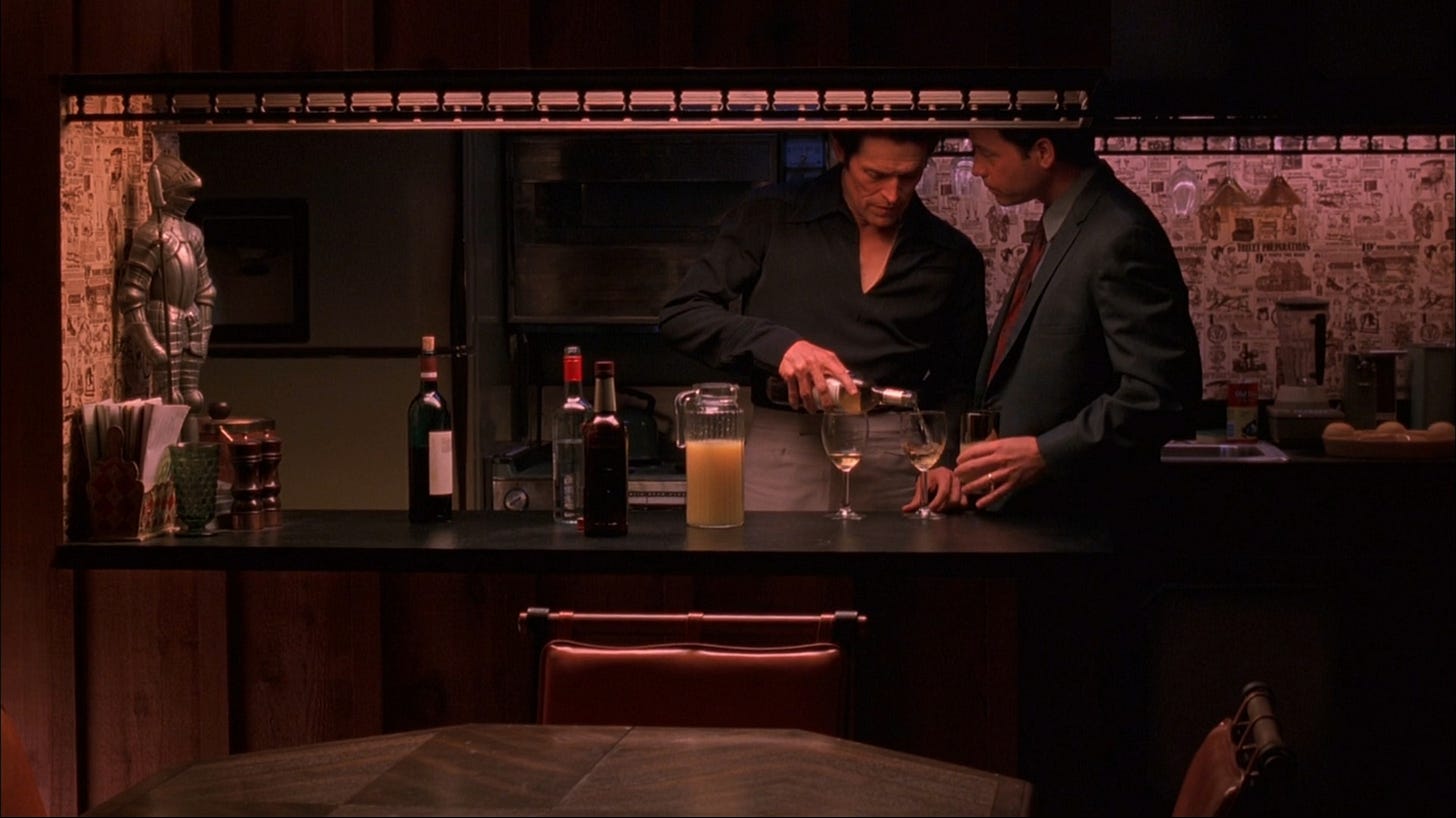
These are the outrés: the weird, bizarre, and controversial. Like Something for Everyone (1970), a British Teorema from Harold Prince in which Michael York seduces a household — including Angela Lansbury (!); Peter de Rome’s Adam and Yves (1974), a gay pornographic film that contains the last known footage of Greta Garbo; and Pedro Almodóvar’s punk debut feature, Pepi, Luci, Bom and Other Girls Like Mom / Pepi, Luci, Bom y otras chicas del montón (1980), which includes a raucous dick-measuring contest put on at a nightclub. Then there’s the films of lesser-discussed groundbreaking filmmakers like Eloy de la Iglesia, Andy Milligan, Vicente Aranda… there’s Hungarian lesbian period pieces, Bruce La Bruce, cult rock musical adaptations of Jean Cocteau's Orpheus from Jacques Demy, pinku films, and HBO’s first gay-themed TV film (starring Harvey Fierstein and Stockard Channing!). These are the films that make programming truly fun.
BONUS: My Prime Programming!
Overwhelmed? Unclear where to start? Here’s my personal list of 21 terrific queer films to watch this Pride (in no particular order):
Vapors (1965) Dir. Andy Milligan
Forgotten pre-Stonewall gay filmmaker Andy Milligan helmed this stunning short film, which uses the setting of a gay bathhouse to stage a tender interaction between two lost, lonely individuals.
Available to watch on Youtube.
Stranger by the Lake (2014) Dir. Alain Guiraudie
This (extremely sexy) NC-17 rated French erotic thriller stages a cold murder mystery entirely onsite of a public lakefront park that’s used for cruising; a new queer classic and seemingly dark commentary on the gay male community’s fetishistic worship of perfectly sculpted bodies.
Available to watch on Amazon Prime (via Strand Releasing)
Swoon (1992) Dir. Tom Kalin
A lesser-known classic of the New Queer Cinema movement, this black-and-white dramatization of the Leopold & Loeb murder case reframes it as a doomed gay love story; a perfect companion watch to Alfred Hitchcock’s more-famous handling of the same material, Rope (1948).
Available to watch on Youtube.
Cecil b. Demented (2000) Dir. John Waters
After you’ve plowed through the oft-discussed John Waters’ classics, your Pink Flamingos and Female Troubles, you’re ready to watch this insanely underrated classic from the Pope of Trash, the favorite film of gay cinephiles everywhere, a satirization of guerilla filmmaking and outré film culture, as irreverent as it is deeply, deeply funny; death to those who support mainstream cinema!
Streaming on Amazon Prime and Tubi.
Splendor (1999) Dir. Gregg Araki
This charming exemplification of blown-out, Millenium cusp maximalism is low-key one of the only films to sensitively depict a MWM throuple, and does so with Araki’s signature wit and irreverence (like, everyone wants two boyfriends, but no one wants to live with two messy-ass men, you know?) A bi classic!
Available to watch on Youtube
Sebastiane (1976) Dir. Derek Jarman
A sun-soaked erotic arthouse historical spectacle that marries past and present as typical of Jarman’s post-modern works; the filmmaker’s debut, it’s usually seen as notable for its rare incorporation of spoken Latin… it’s also hot as hell, which seems most relevant when talking about gay-interest erotic cinema.
Can be streamed in low-quality on Archive.org; it’s also available on Blu-Ray.
Taboo / Gohatto (1999) Dir. Nagisa Oshima
Groundbreaking Japanese filmmaker Nagisa Oshima (In the Realm of the Senses, Merry Christmas, Mr. Lawrence) pushed the boundaries of censorship forward with his cinematic depictions of sex and political progressivism in post-War Japanese cinema, but this, his final film, about a pretty young man who captivates an entire Shinsengumi (an elite group of samurai warriors), might be the best film that’s never talked about, owing to its fraught distribution in the digital era.
You can view the film over at Rarefilmm, an invaluable online resource for watching difficult-to-find movies.
Tongues Untied (1989) Dir. Marlon Riggs
Marlon Riggs’ genre-defying masterpiece of black queer filmmaking weaves poetry from his friend, Essex Hemphill, as well as contemporary black queer street culture, black music, and personal anecdote… making this one of the most personal, and vibrant, works of the late 20th century.
Streaming on the Criterion Channel.
Lan Yu / 藍宇 (2001) Dir. Stanley Kwan
This achingly tender, beautifully-rendered Chinese film, filmed in secret to circumvent state censors, tells the story of a closeted, middle-aged businessman and the young gay student he begins a relationship with, set against a wider backdrop of significant political unrest and cultural change in urban Beijing; extremely hot (and extremely brave), I love this special little film.
Streaming on the Criterion Channel.
Liquid Sky (1982) Dir. Slava Tsukerman
An acid-fueled lesbian punk cult classic about an alien species that infiltrates the underground art scene through the brain of one of its bisexual denizens (the painfully beautiful Anne Carlisle, who plays double-duty as both the targeted female model and her male nemesis, a drug-addict described as "the most beautiful boy in the world") trying to score chemicals released during her orgasms. The film is a blur of fluid sexual encounters and ambiguous gender arrangements, punctuated by a bizarre synth score, infrared special effects, and random acts of violence, as is all typical of the scene at the time: it's seen as having a particular influence on the electroclash scene of the early 2000s.
Streaming on the Criterion Channel.
Velvet Goldmine (1998) Dir. Todd Haynes
Todd Haynes’ rock musical extravaganza is a woefully undersung classic of 20th century filmmaking and the definitive biopic of (ex-bisexual) David Bowie and the genderqueer ethos of the glam rock error: given an infamous roll-out on release by distributor Miramax, the film, a true cult classic, was also trashed on release by mainstream straight critics who didn’t understand the references to queer culture Haynes’ was deftly weaving into his grand operatic vision of gay excess. Mo and I rewatched this at Tribeca with Haynes and longtime producer Christine Vachon in the audience and during the (rare good) Q&A, dominated by gay fans who grew up in its glittery shadow, you could tell how happy he was to finally see it with a crowd that “got” it.
Available to rent on digital platforms.
Bent (1997) Dir. Sean Mathias
The opposite of a feel-good watch for Pride, this sobering, quietly revolutionary little film has been completely forgotten by time: seemingly due to the material and its prohibitive NC-17 rating (owing to some incredibly tame gay sex scenes). Clive Owen stars as a freewheeling nightclub owner in Berlin who is captured and sent to a concentration camp because of his homosexuality; rather than simple torture-porn, the film is unlike anything else I have ever seen, a desperate probe capturing the full spectrum of humanity (and queer identity) in the face of horrific prosecution and incarceration.
Streaming on Tubi.
Who Killed Teddy Bear? (1965) Dir. Joseph Cates
Then-closeted former teen heartthrob Sal Mineo bares himself (and his surprisingly buff physique) in this strange, queer-coded proto-slasher, set against the seedy backdrop of pre-gentrified Times Square, about a nightclub employee (and his lesbian boss, played by Elaine Stritch!) who become psychosexually obsessed with a pretty singer.
Streaming on Amazon Prime.
Hidden Pleasures / Los placeres ocultos (1977) Dir. Eloy de la Iglesia
Made just two years after the death of brutal dictator Francisco Franco (as reference, Almodóvar’s first film came out in 1980), this fascinating film is considered one of the earliest depictions of a gay male protagonist in Spanish cinema and is a stirring articulation of queer liberation masquerading as gay melodrama (the story, on paper, seems pedestrian, though the film itself is anything but: a closeted, middle-aged banker falls in love with a poor 18-year-old student, igniting a firestorm).
Streaming on Tubi.
I Love You, Philip Morris (2009) Dir. Glenn Ficarra, John Requa
I’m always trying to convince more people to watch this beautiful little film, part rom-com, part melodrama and a linchpin of our Be Gay, Do Crimes program from 2021. Funny, bittersweet, and way ahead of its time, this dramatization of the crimes of con-artist Steven Jay Russell (a truly never-better Jim Carey), who falls in love with a fellow inmate in a Texas prison (a blonde Ewan McGregor) and devotes himself whole-heartedly to supporting their dream life together, by any means necessary, is the best gay-interest movie you haven’t yet watched.
Streaming on Amazon Prime.
Salome’s Last Dance (1988) Dir. Ken Russell
Firebrand director Ken Russell, who had to be at least a 4 on the Kinsey scale, somehow makes his gayest movie yet, a staging of Oscar Wilde’s Salomé in a brothel attended by Oscar Wilde himself (and his treacherous lover, Lord Alfred Douglas), in one of the few adaptations of Wilde’s work to capture the outrageousness of its author; I genuinely think Oscar Wilde would have loved this movie (once, you know, someone told him what movies are).
Streaming on Plex (free with ads).
Adam and Yves (1974) Dir. Peter de Rome
Peter de Rome is an unsung hero of early queer cinema, fusing the arthouse ethos of Andy Warhol with the erotic storytelling of the “porno chic,” era, during which films with hardcore gay sex were reviewed and advertised in mainstream news publications (Wakefield Poole’s iconic 1971 Fire Island hit, The Boys in the Sand, was advertised in Variety a year before Deep Throat seemingly harkened in the mainstream acceptance of pornographic film). This surprisingly good film includes a stunning Jean Genet-inspired “Narcissus” sequence set in an art museum; amusingly, it also includes the last known footage of Greta Garbo, shot clandestinely by Peter de Rome. Herstory!
The film is not streaming anywhere (legally) or available on physical media, but it can be readily found online.
The Pillow Book (1996) Dir. Peter Greenaway
Postmodern auteur Peter Greenaway directs the best erotic arthouse movie you’ve never heard of: a mash of deadly bisexuality, female interiority, body calligraphy, and literature… the epitome of 90s international chic.
Available to rent on digital platforms.
Auto Focus (2002) Dir. Paul Schrader
Predictably messy bisexual Paul Schrader’s deeply underrated dramatization of the secret proclivities of Hogan's Heroes’s actor Bob Crane: a treatise on the toxicity of twentieth century masculinity, kink, and the crushing nature of the closet, led by an outrageously good Greg Kinnear and a reliably unsettling Willem Dafoe.
Streaming on the Criterion Channel.
Score (1974) Dir. Radley Metzger
Not quite a porno, not quite a sex comedy, this groundbreaking “porno chic” swinger classic from filmmaker Radley Metzger is actually one of the earliest American films to openly depict bisexuality, depicting a couple of swingers who engage in a game to see who can seduce the same-sex member of another couple first. Witty, well-made, and inclusive of various sexual identities and configurations, this movie will upend all of your assumptions about pornographic film (and demonstrate the relative freedom and charm of 1970s erotic filmmaking).
Available to rent on digital platforms, though note that there are uncut and censored versions; you can rent the uncensored version through Vimeo.
Loves Lies Bleeding (2024) Dir. Rose Glass
Set in 1989, this gloriously lurid and surprisingly acerbic film depicts the love story between a bisexual bodybuilder (newcomer Katy O’Brian) and the gym-managing, steroid-distributing lesbian (Kristen Stewart) who worships her despite the interference of her gangster father (Ed Harris!). Easily my favorite film of this year thus far.
Available to rent on digital platforms.
Be sure to check out our past queer programming from the archives:
A Deep Beauty, a Sunken Beauty, or "Be Gay, Do Crimes”
Let's Say she Thinks Only About You, Anyway: Gay Villains
Lost and Delirious Below Her Mouth, Bound All Over Me: Lesbian and Bi Cinema
Real “I don’t speak German but I can if you like” hours.




